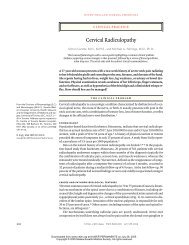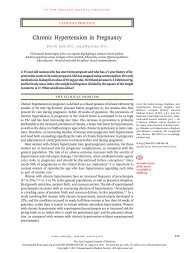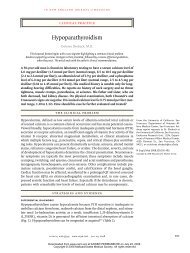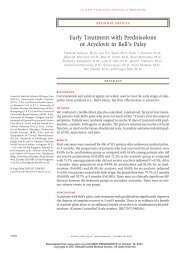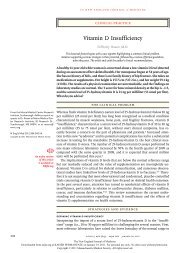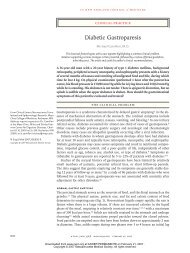Oncologic emergencies for the internist - Cleveland Clinic Journal of ...
Oncologic emergencies for the internist - Cleveland Clinic Journal of ...
Oncologic emergencies for the internist - Cleveland Clinic Journal of ...
You also want an ePaper? Increase the reach of your titles
YUMPU automatically turns print PDFs into web optimized ePapers that Google loves.
ONCOLOGIC EMERGENCIESKRIMSKY AND COLLEAGUESExpertsrecommendpursuing atissue diagnosisin superior venacava syndrome60-mg or a 90-mg dose over at least 2 hours. 18Approximately 60% <strong>of</strong> patients respond to a60-mg dose and nearly 100% to a 90-mgdose. 19 Pamidronate usually takes approximately12 to 48 hours to produce an initialresponse, and <strong>the</strong> response is sustained <strong>for</strong> anaverage <strong>of</strong> about 2 weeks. 20Calcitonin is frequently used in additionto bisphosphonates because it has a rapidonset <strong>of</strong> effect: within 2 to 4 hours <strong>of</strong> administration.21 Its main drawbacks are hypersensitivityreactions and tachyphylaxis; <strong>the</strong> latterusually develops within 3 days.Gallium nitrate and plicamycin are usedinfrequently because <strong>of</strong> <strong>the</strong>ir toxicity.Steroids are frequently helpful in <strong>the</strong>short term, especially in sensitive tumors suchas lymphoma and myeloma.Dialysis remains an option <strong>for</strong> those whocannot tolerate a saline load.■ SUPERIOR VENA CAVA SYNDROMESuperior vena cava syndrome is relatively rare,affecting 2.4% to 4.2% <strong>of</strong> lung cancerpatients, who account <strong>for</strong> 65% <strong>of</strong> all cases. 22Small cell lung cancer is <strong>the</strong> most frequentcause <strong>of</strong> <strong>the</strong> syndrome because it has apredilection <strong>for</strong> <strong>the</strong> central region <strong>of</strong> <strong>the</strong>lungs. 23 Lymphoma accounts <strong>for</strong> 8% <strong>of</strong> cases,and breast cancer and o<strong>the</strong>r mediastinalmetastatic lesions account <strong>for</strong> 10%. 22Of note: several nonmalignant diseasessuch as granulomatous and fibrosing mediastinitis,goiters, and aortic aneurysms can alsocause superior vena cava syndrome.Features <strong>of</strong> superior vena cava syndromeSuperior vena cava syndrome results from anincrease in central venous pressure caused byvena caval obstruction. Typically this producescough, dyspnea, and dysphagia combinedwith swelling and discoloration <strong>of</strong> <strong>the</strong>neck, face, or upper extremities. Dependingon <strong>the</strong> site <strong>of</strong> <strong>the</strong> disease, both vocal cordparalysis and Horner syndrome (sinking in <strong>of</strong><strong>the</strong> eyeball, ptosis <strong>of</strong> <strong>the</strong> upper eyelid, elevation<strong>of</strong> <strong>the</strong> lower lid, constriction <strong>of</strong> <strong>the</strong> pupil,narrowing <strong>of</strong> <strong>the</strong> palpebral fissure, andanhidrosis and flushing <strong>of</strong> <strong>the</strong> affected side <strong>of</strong><strong>the</strong> face; caused by compression <strong>of</strong> sympa<strong>the</strong>ticnerves) can occur.Treatment <strong>of</strong> superior vena cava syndromeInitial treatment consists <strong>of</strong> elevating <strong>the</strong>head <strong>of</strong> <strong>the</strong> bed and giving diuretics and corticosteroids.However, corticosteroids are moreuseful when <strong>the</strong> cause <strong>of</strong> <strong>the</strong> obstruction islymphoma ra<strong>the</strong>r than lung cancer.Chemo<strong>the</strong>rapy and radiation <strong>the</strong>rapy.Unless tracheal obstruction is present orimpending, superior vena cava syndrome isnot immediately life-threatening, and mostexperts recommend pursuing a tissue diagnosisso that specific treatment can be given <strong>for</strong> <strong>the</strong>primary tumor alongside treatment <strong>for</strong> <strong>the</strong>symptoms. 22Both primary chemo<strong>the</strong>rapy and radiationare important components <strong>of</strong> <strong>the</strong>rapy. In smallcell lung cancer, Chan et al 24 found no differencein <strong>the</strong> response rate in patients whoreceived chemo<strong>the</strong>rapy compared with radiation<strong>the</strong>rapy. The recurrence rate <strong>of</strong> superiorvena cava syndrome depends on <strong>the</strong> type <strong>of</strong>tumor causing <strong>the</strong> obstruction. In large celllymphoma <strong>the</strong> high risk <strong>of</strong> recurrence withchemo<strong>the</strong>rapy resulted in a recommendationto use radiation <strong>the</strong>rapy. 25Intravenous stenting can relieve symptoms,particularly dyspnea, <strong>for</strong> most patients.Anticoagulation. Thrombus <strong>for</strong>mationoccurs in up to 50% <strong>of</strong> patients with superiorvena cava syndrome. In a small study,Adelstein et al 26 attempted prophylaxis withfull doses <strong>of</strong> heparin and warfarin but found itconferred no survival advantage when treatedpatients were compared with 10 historicalcontrols. However, anticoagulation is stillused <strong>for</strong> symptom relief regardless <strong>of</strong> effect onsurvival.■ SPINAL CORD COMPRESSIONSpinal cord compression is not immediatelylife-threatening unless it involves level C3 orabove, but it may lead to pr<strong>of</strong>ound, permanentmorbidity. Paraplegia or loss <strong>of</strong> sphincter controlor both not only diminishes a patient’squality <strong>of</strong> life but also predisposes to fur<strong>the</strong>rcomplications such as venous thrombosis,decubitus ulcers, and urinary obstruction.Spinal cord compression occurs at sometime in approximately 5% <strong>of</strong> all cancerpatients, 27 most <strong>of</strong>ten in carcinomas <strong>of</strong> <strong>the</strong>prostate, lung, and breast.214 CLEVELAND CLINIC JOURNAL OF MEDICINE VOLUME 69 • NUMBER 3 MARCH 2002





